Yojana Summary: February 2025 – Energy Sector In India
1. PM-KUSUM: Empowering Farmers with Solar Energy Solutions
- 1. PM-KUSUM: Empowering Farmers with Solar Energy Solutions
- 2. The National Solar Mission: Progress, Challenges, and the Path for Renewable Energy by 2030
- 3. The Perform, Achieve, and Trade (PAT) Scheme
- 4. Smart Cities Mission and the Role of Energy Efficiency in Urban Development
- 5. Scope & Opportunities for Renewable Energy in Rural India
- 6. Green Hydrogen: India’s Path to a Sustainable Energy Future
- 7. Biofuels as Promising Substitute for High Carbon Energy Source
- 8. PRAGATI: Driving India’s Development with Purpose
- 9. Culinary Science and Food Technology in Ancient India: Insights from Pākaśāstra
- Exploring Pākaśāstra: Key Aspects
Introduction
- Agriculture is crucial for India’s development, providing food, nutrition, and livelihoods.
- The Pradhan Mantri Kisan Urja Suraksha Evam Utthaan Mahabhiyan (PM-KUSUM) was launched in March 2019 to integrate solar energy into agriculture.
- There are approximately 5,02,000 solar pumps in the country, reducing CO2 emissions by 1.02 million tonnes annually.
Energy Use in Agriculture
- Irrigation is vital for increasing crop yields and resilience to climate change.
- The irrigated area in India has tripled since the Green Revolution, but reliance on groundwater has increased.
- Energy use in agriculture has shifted from animate to inanimate sources, mainly electricity and diesel.
- Subsidized electricity encourages excessive groundwater use, threatening water security.
- Energy consumption in agriculture contributes 8-11% of India’s total carbon emissions.
PM-KUSUM: Objectives and Components
- PM-KUSUM aims to install 34.8 GW of solar capacity by March 2026 through three components:
- Component-A: Setting up solar power plants (500 kW to 2 MW capacity).
- Component-B: Installing standalone solar-powered irrigation pumps.
- Component-C: Solarising existing grid-connected irrigation pumps.
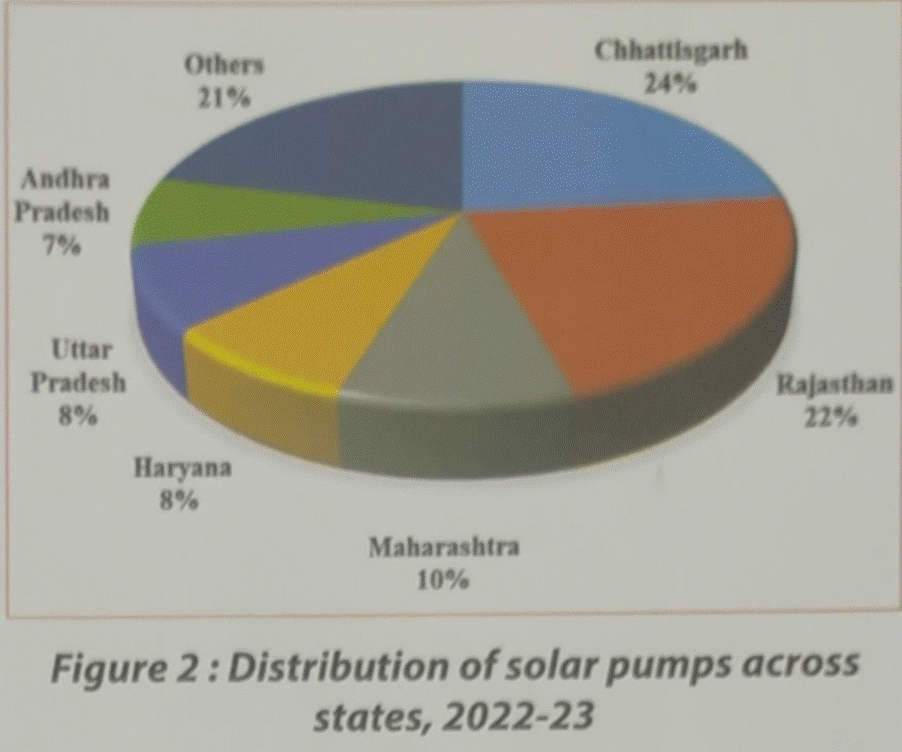
Benefits of Solar-Powered Irrigation
- Solar-powered irrigation pumps offer several benefits:
- Reduced reliance on fossil fuels.
- Lower operational costs.
- Reduced carbon emissions.
- Enhanced farm income.
- Improved energy efficiency.
- User-friendly operation and minimal maintenance.
Challenges and Opportunities
- The adoption rate of solar-powered irrigation systems is low (2.64%) due to:
- High upfront investment costs.
- Difficulty in accessing credit for farmers.
- Electricity subsidies discouraging solar adoption.
- Concerns about over-extraction of groundwater.
- Lack of institutional mechanisms for integrating solar pumps with water-saving technologies.
- Regional variations in solarisation of irrigation pumps.
Conclusion
- Integrating solar energy into agriculture offers multifaceted benefits, including enhanced farm income, reduced reliance on fossil fuels, and lower operational costs.
- Widespread adoption of solar energy can contribute to reducing carbon emissions and mitigating climate change.
2. The National Solar Mission: Progress, Challenges, and the Path for Renewable Energy by 2030
Introduction
- The National Solar Mission aims to establish India as a global leader in solar energy.
- The Mission has seen significant growth in solar power capacity and various policy initiatives supporting sustainable growth and energy security.
- Key programs like PM-KUSUM and PM-Surya Ghar: Muft Bijli Yojana boost renewable energy production and empower farmers.
- The ‘Make in India’ campaign and the Production Linked Incentive (PLI) Scheme promote domestic solar manufacturing.
Progress and Achievements
- India’s solar power capacity has expanded significantly, reaching 94.17 GW as of November 2024.
- Millions of people in rural areas have benefited from solar power, meeting their cooking and lighting needs.
- The Mission has contributed to India’s National Action Plan on Climate Change (NAPCC) and Nationally Determined Contribution (NDC) target.
- Competitive auctions for solar projects have driven record-low solar power prices.
Key Initiatives and Schemes
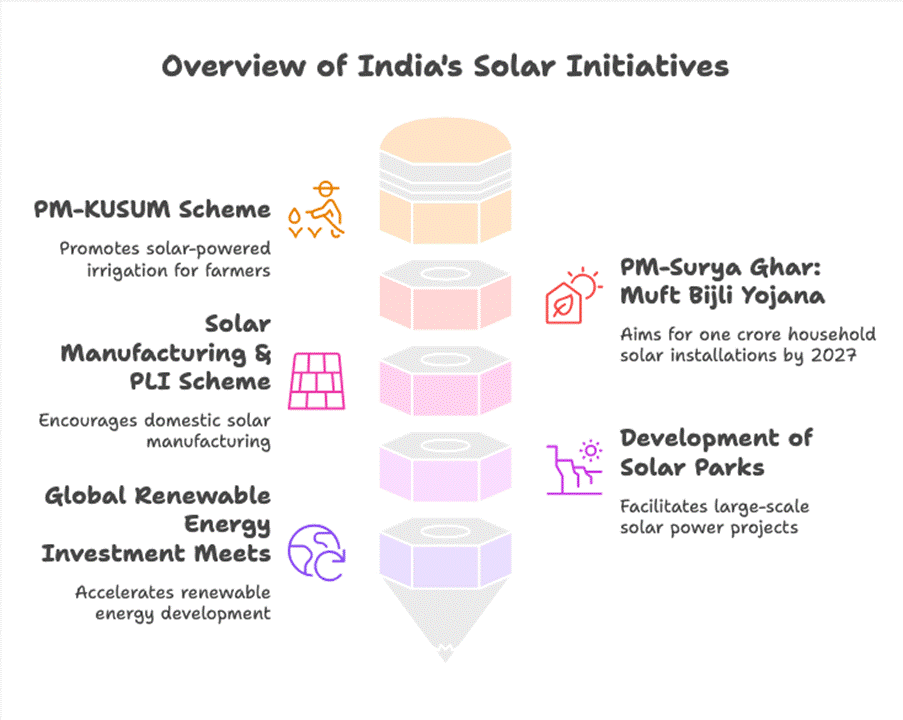
Challenges
- The solar energy sector faces challenges such as land acquisition, transmission infrastructure, power purchase agreements, and energy storage.
- Collaborative efforts are needed to address these challenges and ensure the smooth implementation of policies.
Path for 2030
- Ensuring the quality and reliability of solar products is crucial for the development of solar power in India.
- State-level policies will play a critical role in achieving the government’s renewable energy targets.
- Prioritising solar PV cell manufacturing in India and reducing reliance on imports is essential for a strong clean energy future.
Conclusion
- The National Solar Mission is transforming India’s energy landscape, reducing dependence on fossil fuels, combating climate change, and providing sustainable energy solutions.
- The Mission’s success is a testament to the power of bold vision and collective effort in driving the transition towards a cleaner, greener future.
3. The Perform, Achieve, and Trade (PAT) Scheme
Introduction
- India’s ambitious national goals under the Viksit Bharat and Atmanirbhar Bharat programmes focus on economic growth and addressing equity and poverty issues.
- Energy is crucial for economic growth but faces challenges like increasing demand, climate change, and pollution.
- The PAT mechanism under the National Mission for Enhanced Energy Efficiency aims to improve energy efficiency in industrial sectors.
- The PAT scheme has shown success in reducing energy consumption and CO₂ emissions, contributing to India’s energy intensity and net-zero goals.
Energy Efficiency in India
- India has crossed 200 GW of installed renewable energy capacity, accounting for about 46% of the total installed capacity.
- The country aims to reduce the energy intensity of its economy by 45% by 2030 and achieve net-zero emissions by 2070.
- Energy efficiency is crucial for tackling climate change and meeting the surging energy demand.
- The Energy Conservation Act, 2022 provides a legal framework for energy efficiency measures in key sectors.
The PAT Mechanism
- The PAT mechanism drives energy efficiency improvements in energy-intensive industries in a phased manner.
- The Bureau of Energy Efficiency (BEE) is the lead agency for designing and implementing PAT.
- The PAT scheme involves setting energy-saving targets, implementing measures, and trading Energy Saving Certificates (ESCerts).
PAT Cycle and Implementation
- A PAT cycle is typically three years, during which Designated Consumers (DCs) implement energy efficiency measures.
- ESCerts are issued to DCs that exceed their energy-saving targets.
- ESCerts can be used to offset future targets or sold to other DCs.
- The PAT scheme has resulted in significant energy savings and CO₂ emission reductions across various sectors.
Challenges and Way Forward
- Challenges in PAT implementation include low ESCert trading prices, target-setting issues, and the need to expand to more sectors.
- The PAT scheme can be further strengthened by addressing these challenges and expanding to include MSMEs and the buildings sector.
- Integrating with the Carbon Credit Trading System (CCTS) can enhance PAT’s role in achieving net-zero goals.
Conclusion
- The PAT scheme is a successful initiative for improving industrial energy efficiency in India.
- Continuous improvement and adaptation of the PAT mechanism are crucial for contributing to India’s development goals and achieving a sustainable energy future.
4. Smart Cities Mission and the Role of Energy Efficiency in Urban Development
Introduction
- India’s Smart Cities Mission (SCM), launched in 2015, aims to integrate infrastructure and technology for effective urban growth.
- Cities account for 50-60% of global greenhouse gas (GHG) emissions, highlighting the need for a low-carbon economy through efficient energy supply and consumption.
- Energy efficiency is crucial for reducing household costs, balancing energy demand and supply, and strengthening climate resilience.
Energy Efficiency in Smart Cities
- Power demand in India is expected to double by 2030 due to economic expansion and urbanisation.
- Energy-efficient techniques are essential for minimising consumption, improving distribution processes, and influencing consumer behaviour.
- SCM focuses on key sectors like buildings, water management, waste management, and transportation to promote energy efficiency.
Key Focus Areas
Energy-Efficient Buildings
- The building sector accounts for over a third of India’s energy consumption.
- Retrofitting existing buildings and incorporating energy-efficient systems in new constructions can significantly reduce energy consumption.
- Green building standards like GRIHA and LEED promote sustainable construction practices.
Energy-Efficient Water Management
- The CSCAF 2.0 framework guides cities in reducing energy consumption and promoting sustainable water management.
- Technological interventions like SCADA automation, VFDs, and real-time monitoring systems can enhance energy efficiency in water management.
Energy-Efficient Waste Management
- Waste management requires significant energy for collection, processing, and disposal.
- Technologies like IoT, sensor-based mechanisms, and AI can optimise waste collection and treatment processes.
- Recycling and reusing materials from construction and demolition waste can reduce energy consumption.
Energy-Efficient Transportation
- The transportation sector is a major contributor to GHG emissions.
- Promoting public transportation, non-motorised modes, and electric vehicles can reduce emissions and improve energy efficiency.
- AI and big data analytics can optimise traffic operations and reduce energy demand.
Policy and Regulatory Framework
- Various national policies and programs support the integration of energy-efficient solutions in cities.
- The shift from conventional frameworks like the Energy Conservation Act (2001) to industry- and consumer-oriented programs reflects an evolving policy landscape.
Conclusion
- India is progressively focusing on energy demand management, renewable energy capacity enhancement, and maximising energy efficiency to achieve sustainable urban development.
- A systems approach involving co-production of knowledge, cutting-edge technologies, strategic financing, and performance measurement is crucial for transitioning towards energy-efficient smart cities.
5. Scope & Opportunities for Renewable Energy in Rural India
Introduction
- India’s renewable energy capacity has grown significantly, reaching 203.1 GW in 2024, accounting for 46.3% of the country’s total installed capacity.
- The rural population accounts for about 67% of the total population and 37% of its GDP.
- While the overall Indian economy is expected to grow in excess of 7%, rural India still lags substantially due to a lack of basic infrastructure, including electricity, clean water, and sanitation.
- Nearly 300 million people in rural India lack access to grid-connected power, leading to the use of archaic energy sources like kerosene, diesel, and wood-fired chulhas, which result in health hazards and government subsidies.

Solar Energy: A Promising Solution for Rural India
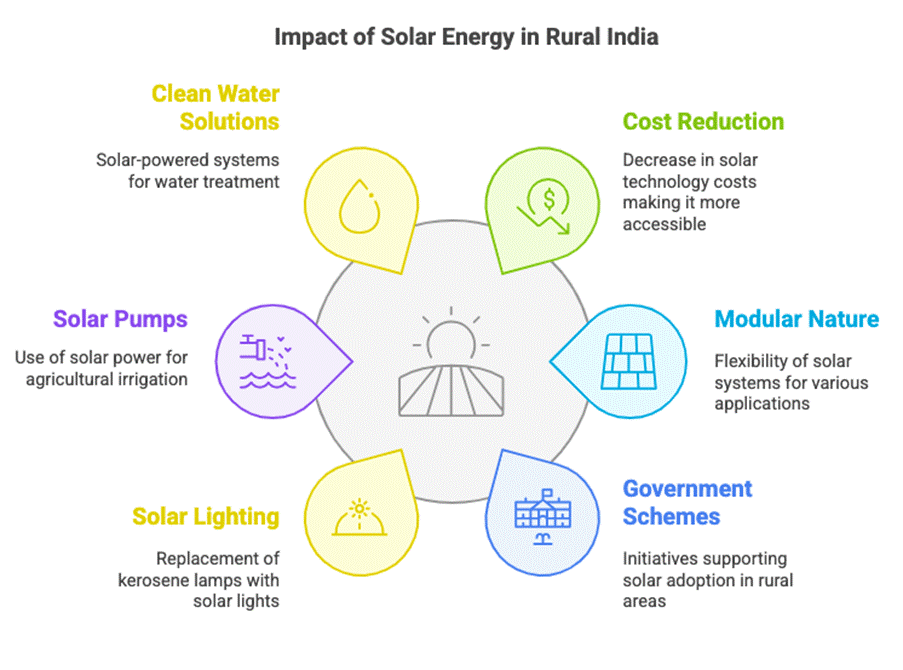
Government Initiatives to Promote Renewable Energy
- The Government of India has strongly supported solar power, particularly distributed solar power, and has sanctioned 4,604 distributed solar projects in rural areas to power 4,745 villages/hamlets.
- Key government measures and initiatives include:
- Permitting Foreign Direct Investment (FDI) up to 100% under the automatic route.
- National Green Hydrogen Mission: Targets 5 MMT of annual Green Hydrogen production capacity by 2030.
- Waiver of Inter State Transmission System (ISTS) charges for inter-state sale of solar and wind power for projects to be commissioned by June 30, 2025, green hydrogen projects until December 2030, and offshore wind projects until December 2032.
- Setting up Ultra Mega Renewable Energy Parks to provide land and transmission to renewable energy developers on a plug-and-play basis.
- Schemes such as Pradhan Mantri Kisan Urja Suraksha evam Utthaan Maha Abhiyan (PM-KUSUM), Solar Rooftop Phase II, 12000 MW CPSU Scheme Phase II, etc.
- PM Surya Ghar: Muft Bijli Yojana: Aimed to install rooftop solar plants in one crore households with a total financial outlay of Rs 75,021 crore and to be implemented until FY27.
- Laying of new transmission lines and creating new substation capacity under the Green Energy Corridor Scheme for the evacuation of renewable power.
- Setting up of Project Development Cell for attracting and facilitating investments.
- Standard Bidding Guidelines for tariff-based competitive bidding process for procurement of power from grid-connected solar PV and wind projects.
- Government orders for power dispatch against Letter of Credit (LC) or advance payment to ensure timely payment by distribution licensees to renewable energy generators.
- Cabinet approval for a Viability Gap Funding scheme for offshore wind energy projects, facilitating the installation of 1 GW of offshore wind energy capacity along the coasts of Gujarat and Tamil Nadu.
- The ‘National Repowering and Life Extension Policy for Wind Power Projects, 2023’ has been released.
- Strategy for Establishment of Offshore Wind Energy Projects: Outlines a bidding trajectory of 37 GW by 2030.
- Offshore Wind Energy Lease Rules, 2023: Notified to regulate the grant of leases for offshore wind energy development.
- Procedure for Uniform Renewable Energy Tariff (URET) established.
- Standard & Labelling (S&L) programs for Solar Photovoltaic modules and grid-connected solar Inverters launched.
- A transmission plan has been prepared to augment transmission infrastructure until 2030.
- Launched the Green Term Ahead Market (GTAM) to facilitate the sale of renewable energy power through exchanges.
Union Budget 2024-25 and Renewable Energy
- In the Union Budget 2024-25, the government has identified energy as a priority sector, with an overall allocation of an estimated Rs 68,769 crores.
- The budget emphasizes the development of new strategies for strengthening the transition to renewable energy sources and promoting energy security in terms of ‘accessibility, affordability, and availability.’
- The growth of nuclear energy in the form of small modular reactors has been emphasized, with the government planning to make it a significant portion of the energy mix for Viksit Bharat.
Challenges Facing the Renewable Energy Sector in India
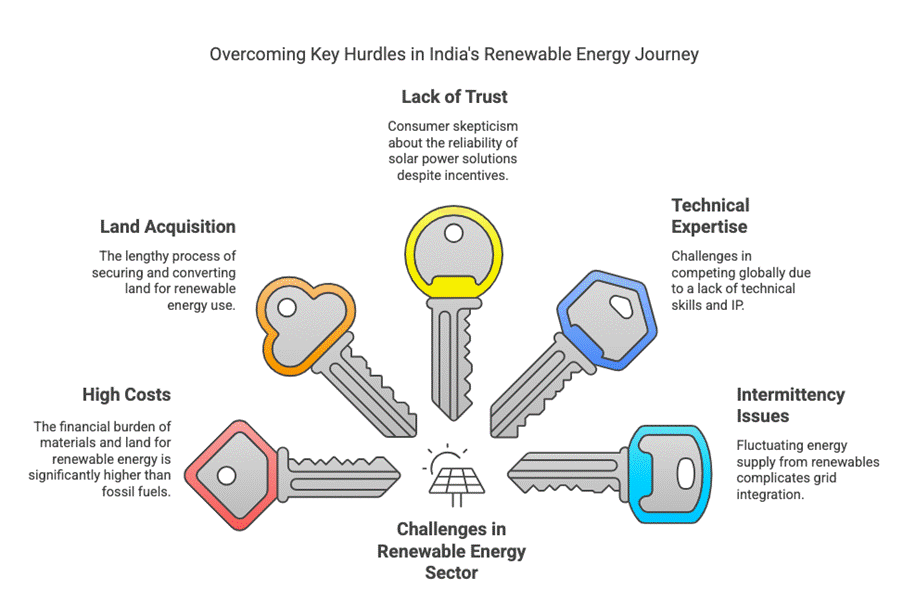
Pradhan Mantri Surya Ghar: Muft Bijli Yojana
- The Pradhan Mantri Surya Ghar: Muft Bijli Yojana was launched to install rooftop solar plants in 1 crore households, providing up to 300 units of free electricity per month.
- The scheme has seen significant interest, with over 1.28 crore registrations and 14 lakh applications, but the final approval for installation lies with the respective state electricity boards, which face challenges due to transformer capacity and grid infrastructure limitations.
Conclusion
- Proactive initiatives and ambitious targets position India as a global leader in renewable energy, contributing to environmental sustainability, energy security, and rural prosperity.
- Addressing the challenges and continuing the holistic approach to renewable energy development will ensure that India meets its energy needs while addressing climate change and resource conservation.
6. Green Hydrogen: India’s Path to a Sustainable Energy Future
Introduction
- India is committed to achieving energy independence by 2047 and Net Zero emissions by 2070.
- Green Hydrogen is a key component of this vision, offering a clean energy solution to revolutionize India’s energy landscape.
- The National Green Hydrogen Mission aims to build a robust Green Hydrogen ecosystem in India, addressing the opportunities and challenges of this emerging sector.
Green Hydrogen: A Global Perspective
- The global transition to clean energy is accelerating, driven by climate change concerns, energy security needs, and economic growth aspirations.
- Green Hydrogen, produced from renewable sources, has the potential to decarbonize hard-to-abate sectors like industry, transport, and power generation.
- India’s leadership in Green Hydrogen is significant as countries scale up production and adoption.
Advancing Energy Independence and Sustainable Development
- India’s energy demand is projected to grow by 25% by 2030, with over 40% of its primary energy currently imported.
- Green Hydrogen can reduce carbon emissions and improve energy self-sufficiency by replacing fossil fuels in various industries and applications.
- The growing demand for Green Hydrogen presents an opportunity for India to become a leading producer and exporter.
- The National Green Hydrogen Mission will accelerate India’s efforts in achieving a low-carbon, self-reliant economy.
National Green Hydrogen Mission (NGHM)
- Launched in January 2023, the NGHM aims to establish India as a global hub for Green Hydrogen production, usage, and export.
- The Mission targets a production capacity of at least 5 MMT of Green Hydrogen annually by 2030, with potential growth to 10 MMT per year.

Scaling Green Hydrogen Production
- India currently consumes about 5 MMT of Hydrogen annually, primarily sourced from fossil fuels (Grey Hydrogen).
- The NGHM aims to scale up Green Hydrogen production technologies and reduce costs related to electrolyzers, renewable energy inputs, and infrastructure.
- The Mission proposes increasing electrolyzer capacity, boosting domestic production, and exploring innovative decentralized models for Green Hydrogen production.
- Infrastructure for storing, delivering, and exporting Green Hydrogen will be developed, including Hydrogen Hubs and export facilities.
Coordinated Efforts and Governance
- The NGHM requires coordinated efforts across multiple ministries, departments, and institutions at both central and state levels.
- The Ministry of New and Renewable Energy (MNRE) leads the Mission, while other ministries play crucial roles in facilitating Green Hydrogen adoption in their respective sectors.
- A comprehensive governance structure, including an Empowered Group and a National Green Hydrogen Advisory Group, will oversee the Mission’s implementation.
Economic and Environmental Outcomes
- The NGHM is expected to drive economic benefits through decarbonization, reduced fossil fuel imports, domestic manufacturing, job creation, and technological innovation.
- The Mission aims to create a large-scale Green Hydrogen ecosystem, attracting investments and generating employment opportunities.
- Green Hydrogen initiatives are expected to avert around 50 MMT of CO2 emissions annually, contributing to India’s Net Zero goals.
Financial Outlay and Risk Management
- The initial funding for the NGHM is Rs 19,744 crore, allocated to various components, including the SIGHT program, pilot projects, R&D, and other initiatives.
- The Mission incorporates effective risk management strategies to address potential challenges related to supply chains, technology, operations, finance, and market risks.
Conclusion
- Green Hydrogen is crucial for India’s sustainable energy future and decarbonization efforts.
- The NGHM will build a robust Green Hydrogen ecosystem, fostering innovation, attracting investment, and driving economic growth.
7. Biofuels as Promising Substitute for High Carbon Energy Source
Introduction
- The demand for energy is rising, but fossil fuels are no longer viable.
- Biofuels, derived from renewable biomass, offer a strategic advantage for sustainable development and energy security.
- The National Policy on Biofuels (NPB) 2018 aims to augment biofuel generation and build a sustainable ecosystem.
- Jatropha curcas is identified as a key non-edible feedstock for biodiesel production.
The Need for Alternative Energy Sources
- Access to affordable and clean energy is essential for health, development, and well-being.
- Conventional energy sources are causing harm to the environment.
- Alternative energy sources are needed to mitigate climate change, biodiversity loss, and pollution.
- Biofuels have emerged as an ideal choice to meet India’s energy requirements in a sustainable manner.
Biofuels in India
- India started its biofuel initiative in 2003, focusing on molasses for bioethanol and non-edible oil for biodiesel.
- Challenges in biofuel production include inconsistent production, high costs, land availability, and choice of feedstock.
- A coherent and committed policy with a long-term vision can sustain India’s biofuel efforts, providing energy security, economic growth, and a higher quality of life.
Benefits of Biofuels
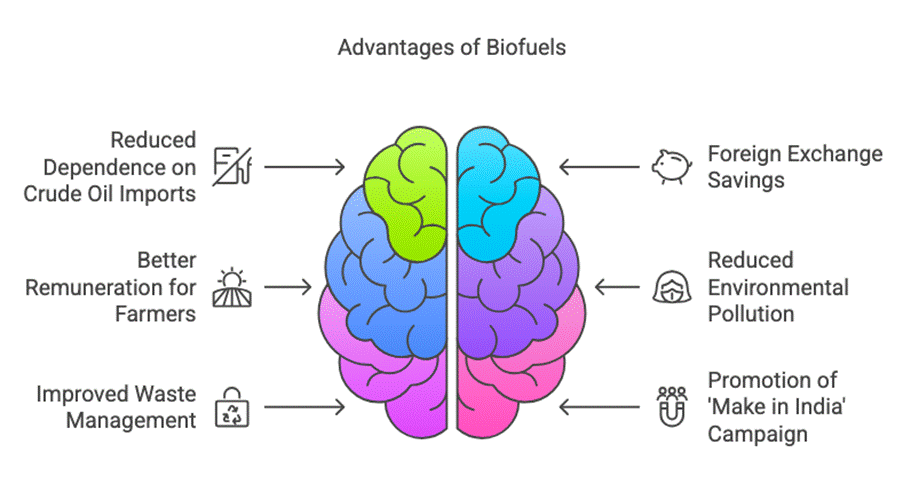
Household Energy and Biofuels
- Household energy is vital for maintaining good health, but unaffordable and inadequate energy access can have adverse consequences.
- Biofuels can provide a viable solution for household energy needs, offering social and environmental benefits.
Biofuels: A Sustainable Energy Source
- Biofuels are renewable fuels derived from biomass, primarily used for transportation, heat, and power generation.
- Ethanol and biodiesel are the most common biofuels, offering environmental benefits and reducing greenhouse gas emissions.
- Biofuels promote sustainable development, reduce dependence on fossil fuels, and enhance national energy security.
Jatropha Curcas: A Promising Feedstock
- Jatropha curcas is a non-edible oilseed identified as a suitable feedstock for biodiesel production in India.
- Jatropha can be grown in diverse conditions, including arid zones and degraded landscapes.
- It is resistant to pests and diseases, attracts pollinators, sequesters carbon, and provides valuable byproducts.
National Policy on Biofuels (NPB)
- The NPB 2018 aims to augment biofuel generation and build a sustainable biofuel ecosystem in India.
- The government aims to meet 20% of the country’s diesel demand with biofuels, requiring significant land resources and investment.
- The NPB 2022 amendment advanced the deadline for achieving 20% bioethanol blending in petrol to 2025-26 and expanded the range of eligible feedstocks.
Challenges and Opportunities
- Challenges for biofuel development include the need for research and development, technology transfer, mainstreaming biofuel adoption, and promoting sustainable production practices.
- Biofuels offer opportunities for reducing greenhouse gas emissions, improving air quality, and promoting rural development.
Conclusion
- Biofuels are a promising alternative to fossil fuels, offering a pathway towards sustainable energy production and consumption.
- By addressing the challenges and harnessing the opportunities, India can leverage biofuels to achieve energy security, environmental sustainability, and economic growth.
8. PRAGATI: Driving India’s Development with Purpose
Introduction
- The PRAGATI (Pro-Active Governance and Timely Implementation) initiative has been instrumental in accelerating infrastructure development and improving governance in India.
- Launched in 2015, PRAGATI embodies the ‘Minimum Government, Maximum Governance’ approach, leveraging technology and collaboration to fast-track progress.
Key Features and Achievements
- PRAGATI champions collaboration, transparency, and technology to ensure efficient project management and timely implementation.
- The initiative has reviewed 340 stalled projects worth Rs 17.05 lakh crore ($205 billion) since its launch, significantly reducing delays and expediting completion timelines.
- PRAGATI has streamlined environmental and forest clearances, cutting down approval times from 600 days to 70-75 days and from 300 days to 20-29 days, respectively.
- The initiative has also improved the efficiency of grievance redressal mechanisms, such as CPGRAMS, and reduced passport issuance time.
Impact on Key Projects
- PRAGATI has played a crucial role in accelerating several key infrastructure projects, including:
- Bogibeel Rail and Road Bridge: Completed in 3 years after over two decades of delays.
- Jammu-Srinagar Baramulla Rail Link: On track for completion by 2025, overcoming years of stagnation.
- Navi Mumbai Airport: Resolved land acquisition hurdles and set for launch by December 2024.
- Bengaluru Metro Rail: Expedited land acquisition for Phase 1, enabling the metro’s launch in 2017.
- Haridaspur-Paradeep Rail Connection: Resolved funding and land acquisition issues, leading to the rail line’s inauguration in 2020.
- Dahisar-Surat Section, National Highway 8: Enabled progress on the service road with safeguards for wildlife and compensation for landowners.
- Varanasi-Aurangabad Section, National Highway 2: Addressed land record challenges and expedited the project’s completion.
Leadership and Governance
- PRAGATI has fostered a culture of transparency and responsiveness in the government, leveraging technology for real-time data and proactive problem-solving.
- The initiative exemplifies cooperative federalism, with the Central and state governments working together towards shared goals.
Influence on Other Schemes
- PRAGATI’s success has accelerated technology adoption in other crucial government schemes, including:
- Swachh Bharat Mission: Improved rural sanitation with 12 crore toilets and ODF villages.
- Jal Jeevan Mission: Increased tap water access for rural households from 17% in 2019 to 74% in February 2024.
- Saubhagya Scheme: Achieved universal electrification.
- Vibrant Villages Programme (VVP): Transformed 46 Northeast villages into India’s ‘First Villages’.
- Light House Projects: Promoted innovation in housing construction with digitized technology.
- SVAMITVA Initiative: Enabled legal land ownership records for rural residents using drone technology.
Global Benchmark for Governance
- PRAGATI has set a global benchmark for governance by promoting transparency, accountability, and efficiency in project implementation.
- The use of technology, such as drone feeds and GPS tracking, has enabled real-time data collection and quick decision-making.
- PRAGATI’s digital dashboard approach has enhanced project oversight across various sectors.
- The initiative has also fostered public participation through a robust feedback loop, allowing citizens to influence governance directly.
Conclusion
- PRAGATI has transformed governance in India, demonstrating the power of technology, collaboration, and decisive leadership in driving development and achieving tangible outcomes.
- The initiative’s success serves as an inspiration for other countries seeking to improve infrastructure delivery and enhance governance effectiveness.
9. Culinary Science and Food Technology in Ancient India: Insights from Pākaśāstra
Introduction
- In Indian tradition, food is not just sustenance but also medicine, with its preparation, combination, and consumption deeply intertwined with one’s physical and mental well-being.
- The ancient Indian culinary science, known as Pākaśāstra, provides valuable insights into the art and science of cooking, emphasizing the importance of pure and regulated eating habits for a healthy and fulfilling life.
Food Discourses in Hindu Life
- Food plays a multifaceted role in Hindu life, encompassing three overlapping discourses:
1. Ontological and Experiential Discourse- Explores the cultural significance of food in daily life and social interactions.
- Shapes culinary practices and traditions through shared experiences and rituals.
- 2. Therapeutic Discourse
- Focuses on the healing and health-promoting properties of food.
- Draws connections between diet and well-being, as illustrated by the saying, “food is the greatest medicine.”
- 3. Transcending Discourse
- Emphasizes the role of food in spiritual development and self-realization.
- Advocates mindful eating and dietary regulations as a pathway to self-control and liberation.
Dietetics and Culinary Art in Ancient India
- Ancient India made significant contributions to the fields of dietetics (Pathyāpathyanirnaya) and culinary art (Pākaśāstra and Pākakala).
- Demonstrated a sophisticated understanding of the relationship between food and human health.
- Culinary art, the art of cooking, is deeply rooted in the science of dietetics, applying nutritional knowledge to maintain health and manage diseases.
- While Pākaśāstra is not explicitly listed as one of the eight branches of Ayurveda, it is closely aligned with Ayurvedic principles and concepts.
- Shares a common focus with Ayurveda on the importance of diet in overall well-being.
- The overlap is evident in the exchange of ideas and concepts between Ayurvedic texts and independent works on Pākaśāstra, such as Nala’s Pākadarpaņa.
Exploring Pākaśāstra: Key Aspects
1. Text Sources
- Numerous published works and manuscripts provide valuable insights into ancient Indian culinary knowledge and practices.
- Important texts include Pākadarpaņa, Kṣemakutūhala, and Bhojanakutūhala.
2. Types of Food
- Pākaśāstra classifies various types of food based on:
- Their properties
- Preparation methods
- Effects on the body and mind
3. Food Classification
- The classification system in Pākaśāstra considers factors such as:
- Taste (Rasa) – The six primary tastes influencing digestion and health.
- Potency (Vīrya) – The energetic effect of food, categorized as heating or cooling.
- Post-Digestive Effect (Vipāka) – The transformation of food after digestion, impacting long-term health.
4. Impact of Serving Leaves
- Pākaśāstra recognizes the influence of serving cooked food on different plant-based leaves.
- Acknowledges the potential impact of these leaves on food’s properties and health benefits.
5. Impact of Food on Body and Mind
- Ancient texts highlight the profound connection between food and one’s physical and mental state.
- Emphasizes the importance of mindful eating and dietary choices for overall well-being.
Conclusion
- Pākaśāstra, the ancient Indian culinary science, offers a wealth of knowledge and insights into the art and science of cooking.
- By exploring the principles and practices of Pākaśāstra, we can gain a deeper understanding of the profound relationship between food and human well-being.



